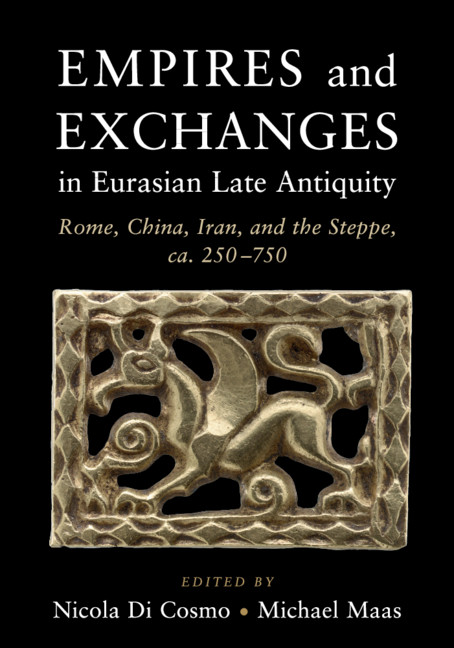Empires and Exchanges in Eurasian Late Antiquity: Rome, China, Iran, and the Steppe, ca. 250–750. Edited by Nicola di Cosmo & Michael Maas. Cambridge: Cambridge University Press, 2018.
After nearly seven years together, it’s safe to say Heather knows my historical preferences fairly well. While she often likes to gift books on topics outside my comfort zone (many of which yield reviews here on Concerning History), sometimes she knows exactly what will pique my interest. Such was the case with Empires and Exchanges in Eurasian Late Antiquity, an edited volume of articles and conference papers that combines my amateur interest in Late Antiquity with my professional specialization in global historical methodology. Indeed, as I eagerly devoured its eclectic contents, I found in its pages a greater appreciation for this seminal period in Eurasian history, one only made possible through its focus on connections and the eliding of traditional borders.
As an edited academic collection, Empires and Exchanges is neither an introductory text nor a single historical narrative. Instead, leading authorities in the field briefly discuss research and reflections on such disparate topics as the existence of an East Roman frontier policy, the evolution of Chinese dynastic legitimacy, Sogdian merchant libraries, and Persian imagery in Central Asian mosaics, just to name a few. As such, it’s hard to write a traditional review, even more so since I’m not sufficiently knowledgeable in these fields to critique most of the cutting-edge research on display.
If nothing else, Empires and Exchanges would earn my glowing recommendation for Ursula Brosseder’s fantastically comprehensive yet cautious chapter. In it, she examines the archaeological evidence for the Huns’ ethnic origins (a long-running, contentious debate that I, like others, have very strong opinions on).
When taken in as a whole volume, all these disparate pieces of scholarship come together to argue persuasively for a new conception of Late Antiquity, at least for me. For years, my fascination with the period has come largely from its current classification as the end of an era. It’s in the name! Antiquity has not ended yet—Western Rome still stands, the forces of Islam have not yet boiled out of Arabia to topple Persia and hamstring Eastern Rome—but the world is no longer the shining marble Classical edifice of Augustus. It’s worn, lived in, falling apart at the seams, with storm clouds on the horizon. Yet it is within Late Antiquity that both the end of Antiquity and the beginning of the medieval period lay, making it both a transitional period and, increasingly, a period worth studying simply on its own terms.
Never before or since has Central Asia impacted the history of three continents as much as during this period, nor have the past three millennia encountered less stability or, arguably, more innovation in all aspects of society. One could even argue for a radical new periodization of European history, one in which antiquity ends with the close of the third century and the Middle Ages begin with the Norman conquest of England. In between can be found an era characterized by a previously unprecedented cultural and economic exchange, the advent of new religions and polities and the transformation of old ones, and the greatest sustained movements of peoples in recorded history, from Germanic tribes to Huns, Avars, Arabs, Slavs, Turks, and Scandinavians.
For as many topics as it discusses, Empires and Exchanges only scratches the surface of this endlessly fascinating period, and for anyone interested in how the ancient world slowly became both recognizable as the origins of the modern world and yet still strange to us, I cannot recommend it (or the many works contained in its bibliographies) highly enough.
